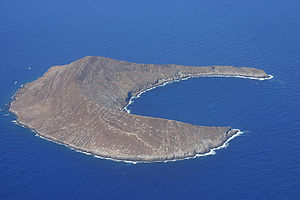Lehua, at 126 ha, is one of the smallest islands in the USA’s Hawaiian chain. The uninhabited island supports breeding populations of several seabird species, including ACAP-listed Black-footed Phoebastria nigripes and Laysan P. immutabilis Albatrosses.

Lehua Island is an an eroded tuff cone
The Lehua Island Restoration Project Partnership aims to rid the island of its invasive Polynesian or Pacific Rats Rattus exulans. A second aerial poison bait drop took place last year, after a previous failed attempt (click here).
This second attempt was initially thought to have been successful, with notable improvements in breeding success of monitored seabirds (click here). However, reports of rats surviving then followed: “Recently, remote, motion-activated monitoring camera “traps” picked up three images of what are believed to be two or three rats on the steep and rocky cliff areas on the west and east sides of the island. Analysis of images show definitive proof of one rat” (click here). As a consequence hand-placed traps and poison bait stations have been deployed in the areas with recent sightings.

A Black-footed Albatross pair on Lehua, photograph by Eric Vanderwerf
It is now intended to utilize rat-detection dogs over the next two months. “Once the [rat] scent is identified, the handlers [will] then help the dogs pinpoint the precise areas where rats are located. The dogs are trained and handled to minimize their interactions with native birds”.
Read more here.
John Cooper, ACAP Information Officer, 19 April 2018

 English
English  Français
Français  Español
Español